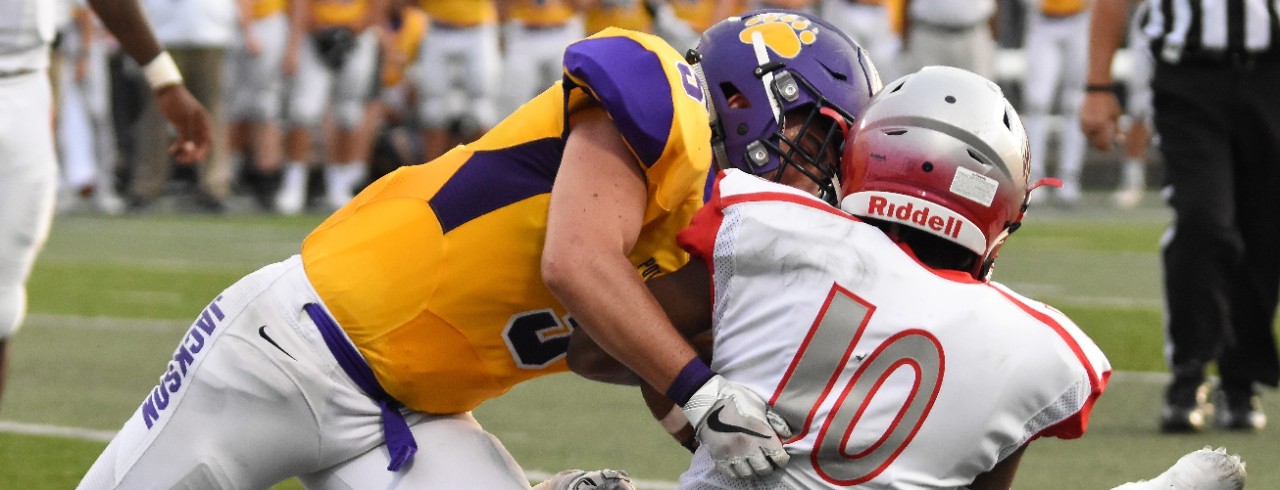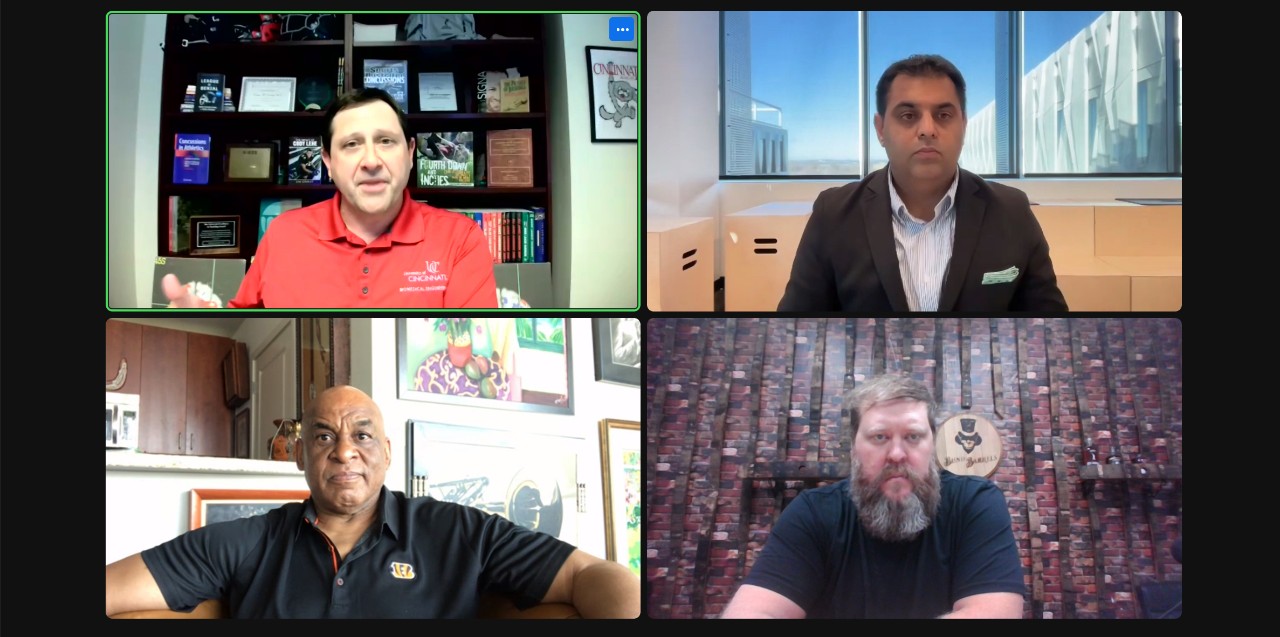
UC research seeks to protect athletes from brain injuries
Flashpoint Series discussion explores effects of concussions on former football players
Former football players worry about the effects of concussions suffered during their playing careers and hope research from the University of Cincinnati will help them and future generations avoid the worst consequences of brain injuries.
UC’s Office of Research hosted a panel discussion in the Digital Futures Flashpoint Series, “Brain Injuries in Sports: How we can help our athletes,” which addressed the effects of brain injuries and how research aims to develop solutions to protect athletes.
“Over the past decade, our society has been becoming aware of the plague of brain injuries many of our athletes are experiencing. Football has been under the microscope,” said Jai Chabria, the panel moderator and managing director at MAD Global Strategy, a public affairs firm now with an office in Columbus, Ohio. “But brain injuries are also a problem in soccer, lacrosse, field hockey, gymnastics and other sports. It hits young men, and it hits young women. It’s very pervasive in our society.”
Along with Chabria, the panel included Tom Talavage, PhD, a professor and head of UC's Department of Biomedical Engineering; Bob DeMars, former University of Southern California football player and award-winning filmmaker whose 2016 documentary, “The Business of Amateurs” took on the NCAA's exploitation of college athletes and the prevalence of brain trauma inherent to college football; and Reggie Williams, former Cincinnati Bengals linebacker and author of the book, “Resilient by Nature: Reflections from a Life of Winning On and Off the Football Field.”

Clockwise from left, Tom Talavage, PhD, a professor and head of UC's Department of Biomedical Engineering; Jai Chabria, managing director at MAD Global Strategy, a public affairs firm; Bob DeMars, former University of Southern California football player and award-winning filmmaker; and Reggie Williams, former Cincinnati Bengals linebacker and author have a conversation during a Flashpoint Series event. Photo/UC Digital Futures
Talavage has spent the past 13 years studying subconcussive injuries or bumps, blows or jolts to the head that do not cause symptoms. This differs from concussions, which do cause symptoms. He’s trying to understand how impacts to the head alter brain physiology in athletes and if repeated head impacts create a greater risk for long-term neurodegenerative disorders including Parkinson’s disease, Alzheimer’s disease and chronic traumatic encephalopathy (CTE).
“All of those repeated acceleration [forces] actually are causing some low level of cellular damage, some low level of structural injury to the brain,” Talavage said, “and, as those accrue time after time after time, that’s when we start to see changes in the actual function, [in] the brain chemistry [and] the brain structure that often are worse than in the case of a diagnosed concussion.”
Williams, a linebacker with the Cincinnati Bengals from 1976 through 1989, said he suffered his first concussion as a high school freshman when he fell out of a tree, an injury that prevented him from playing football that year.
“My head was so swollen I couldn’t fit a helmet on it,” the Dartmouth College alumnus said.
Williams knows of three concussions he suffered while playing football, all of which occurred during his professional career. In the 1987 season finale at Houston, Williams said, he suffered a head injury that the team doctor initially didn't recognize as an injury.
“I hit the ground, and the ground is moving [in my mind] like this,” Williams said. “I don’t know if I can get up, and I just reach out to a pair of orange stockings, assuming that is a teammate. That person pulled me up and got me to the sideline.”
The next time the Bengals were on defense, Williams ran back onto the field even though he didn't know what was going on. Moments later it became clear he had an orbital bone injury around his eyeball in addition to a brain injury.
“I just blow my nose one time, and that forced my eyeball to blow up like a balloon,” he said. “And I ran back to the doctor and said, ‘See, I told you I was hurt.’”
All of those repeated acceleration [forces] actually are causing some low level of cellular damage, some low level of structural injury to the brain. And, as those accrue time after time after time, that’s when we start to see changes in the actual function, [in] the brain chemistry [and] the brain structure that often are worse than in the case of a diagnosed concussion.
Tom Talavage Professor and head of UC's Department of Biomedical Engineering
DeMars, who played defensive end at the University of Southern California from 1997 to 2001, is unsure of how many concussions he suffered but said it was a common occurrence.
“I’ve probably had over a hundred of these things,” he said. “That seemed to happen almost every day in practice.”
The former USC Trojan regularly played while hurt, injured and exhausted. He’s suffered post-traumatic stress disorder from his football career.
“I vomited every August for eight years straight,” DeMars said. “I was traumatized from having to push myself beyond my physical and mental limits. I started vomiting every day, like nonstop. I lost 30 pounds in five days.
“Trading my long-term mental health for the sake of this very ephemeral, fleeting moment of glory that gets romanticized with running out of the tunnel and all that stuff. I’d rather have student debt as opposed to that. And [the University of Southern California] would have been a lot [of student debt]. I am grateful for the opportunities that I had at my school, but I always felt like an athlete-student. I always thought sports were put first, and I didn’t really feel like everybody was looking out for my best interests.”
Athletes are very prideful and don't like to admit their deficiencies, DeMars said. He's vocal about the physical and mental strain he has suffered and made his documentary to decrease the stigma for athletes.
“Since making the film, I've had over 100 athletes come up to me and in hushed tones say, ‘I have what you have,’” he said.
Both DeMars and Williams have seen progress as teams and leagues place more emphasis on protecting their players, but there's still room for improvement. A culture of winning at all costs can cause coaches to neglect their players' health, and players often push themselves too far.
“With athletic trainers and coaches, they need to save the player from themselves,” Williams said. “We want to play. We want to be in the huddle. We want to be with our teammates. We want to win. We want to contribute to winning.”
One of the keys to protecting athletes will be gathering information to determine the risk factors of head impacts, UC's Talavage said.
He wants to figure out if there are individuals who are more or less susceptible to neurodegenerative disorders, which likely have a genetic component. If the risks could be determined, some individuals could be encouraged to avoid impact sports while others could participate in sports while health monitoring.
Data also could help coaches and athletic trainers know when players should be removed from practice, which could in turn keep them healthier for games.
“We are partnered with our sports medicine department,” Talavage said of his work with the UC athletics department. “I believe it’s a wonderful situation here where we have a research-oriented training staff and sports medicine staff. It’s part of the reason why I came here.”
Both DeMars and Williams have pledged to donate their brains to science. After an individuals death, brain banks can look for signs of brain damage.
I think there's a great opportunity to really benefit future generations of aspiring athletes with the research being done now to provide some kind of solution for CTE.
Reggie Williams Former Cincinnati Bengals linebacker and author
Former athletes also are being studied while they're still living, trying to gather information about their lives, their playing history and other information in search of the factors that lead to brain disease.
“I think there's a great opportunity to really benefit future generations of aspiring athletes,” Williams said, “with the research being done now to provide some kind of solution for CTE.”
Williams, who suffers from memory lapses, would like to know if they were caused by concussions, going under anesthesia 28 times for football-related injuries or another factor. The former Bengal also wants to know what he can do to mitigate the effects of his brain injuries.
“My assumption is that I already do have CTE, so my goal is to look at what are solutions today,” he said. “What are [the] opportunities next week? What are things I can be doing in my personal lifestyle that will prevent the most negative aspects of CTE? The most negative aspect is when you get so depressed, I’m told, that you get suicidal. That’s one of the things that I am most concerned about.”
Williams and DeMars would like to know if marijuana, psychedelics, hyperbaric chambers or something else could help ease their symptoms.
DeMars also wants to see more resources for former athletes, such as health insurance that would cover costs associated with their injuries even decades after their playing careers end. He hasn't been able to find anyone who will provide coverage for head injuries, though.
“I couldn’t get anyone to cover it without having the exception of head injuries because we don’t know what that sunken cost is,” he said.
The Flashpoint Series, a series of “conversations of consequence,” is in its third year. The series aims to bring together experts, from UC and beyond, to talk about topics including the heroin epidemic, water quality on the Ohio River and cybersecurity in elections.
Featured image at top courtesy of Unsplash.
Next Lives Here
The University of Cincinnati is classified as a Research 1 institution by the Carnegie Commission and is ranked in the National Science Foundation's Top-35 public research universities. UC's medical, graduate and undergraduate students and faculty investigate problems and innovate solutions with real-world impact. Next Lives Here.
Related Stories
UC students win hackathon in San Francisco
July 22, 2024
With an app that combats food waste and incentivises donations to food banks, two University of Cincinnati students were part of a team that won an artificial intelligence and blockchain hackathon competition in San Francisco. Daniel Vennemeyer, a computer science, economics and mathematics student who also is pursuing a master’s degree in AI through UC’s ACCEND program, and Phan Anh “Rai” Duong, a computer science student, were part of a team that won the grand prize in the EasyA x VeChain Bay Area Hackathon.
UC students' cryptocurrency advice leads to big gains
April 4, 2024
Using recommendations from University of Cincinnati students, a cryptocurrency fund has grown from $50,000 to more than $120,000 in less than 15 months. As part of an economics course, Economic Applications of Blockchain, UC students are challenged to research potential cryptocurrency investments for a fund owned by UC’s Kautz-Uible Economics Institute.
UC Answers: How is UC using design to address COVID-19?
September 1, 2020
Claudia Rebola is an assistant professor and the associate dean for research at the University of Cincinnati’s College of Design, Architecture, Arts, and Planning. She is part of a UC team using innovation and design expertise to respond to COVID-19.
